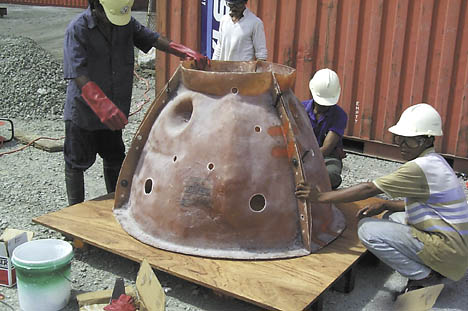

<=Back
November 1999


 C O N
C R E T E C O N
C R E T E

Miner
launches community help scheme in Sulawesi

By
Dave Lennon

PT Newmont Minahasa Raya
(PTNMR), a gold mine situated on the Indonesian island of Sulawesi,
recently launched a community benefit program to help improve local
fisheries and train local fishermen in the production of concrete fish
habitats. PTNMR contracted Sinclair Knight Merz to get the program up and
running.

 The mine is located three hours drive from Manado in an area
called Mesa, and has been in operation for just over three years. The mine
is operated by the US parent company Newmont, and has a policy of
investing in, and assisting the local community. The mine is located three hours drive from Manado in an area
called Mesa, and has been in operation for just over three years. The mine
is operated by the US parent company Newmont, and has a policy of
investing in, and assisting the local community.

 In recent times the local fishermen have complained of reduced
catches. This has been brought about by overfishing and other
unsustainable practices such as "bombing" and cyaniding. Within minutes
such practices destroy coral structures and ecosystems that have taken
hundreds of years to develop. It is an "eat for today" only policy and is
a problem in many poor countries. In recent times the local fishermen have complained of reduced
catches. This has been brought about by overfishing and other
unsustainable practices such as "bombing" and cyaniding. Within minutes
such practices destroy coral structures and ecosystems that have taken
hundreds of years to develop. It is an "eat for today" only policy and is
a problem in many poor countries.

 In many cases, coastal development adds to the fishery problem by
destroying productive coastal habitats and reducing water quality. In many cases, coastal development adds to the fishery problem by
destroying productive coastal habitats and reducing water quality.


A
fibreglass mould is prepared for one of the concrete reef
balls.

PTNMR has a marine
monitoring program in place, and data collected to date have not
identified significant changes to water quality that could account for
reduced catches. However, the data show reduced fish numbers as well as
the occurrence of coral bleaching. Last year has seen global seawater
temperatures rise to unprecedented levels which stresses the corals
sufficiently to cause them to turn bright white. Some do survive, but the
majority fail to regain their colour and die. This bleaching has happened
worldwide and the consensus is that this will have an effect on fisheries.
However, no-one can predict to exactly what scale.

 PTNMR investigated the possibility of constructing artificial
reefs to help enhance areas and also replace lost substrate due to
bombing, cyaniding or coral bleaching. The challenge was, what would be
the best material to use to construct the reefs, and where to construct
them? PTNMR investigated the possibility of constructing artificial
reefs to help enhance areas and also replace lost substrate due to
bombing, cyaniding or coral bleaching. The challenge was, what would be
the best material to use to construct the reefs, and where to construct
them?


Sinclair Knight Merz's Dave Lennon indicates an identifying mark
on one of the finished reef balls. The identifying marks are used for
ongoing monitoring of the fish habitats.

A quick surf of the
internet revealed the home page of the Reef Ball Development Group ( http://www.reefball.com/ ), a
nonprofit organisation that has developed a leading mould system for
producing effective concrete reef modules. These modules are called reef
balls, but the name is misleading as they are not balls, but hollow dome
structures with "Swiss cheese" walls.

 Over 40,000 of these modules have now been deployed around the
world and studies show they mimic natural reefs in form and function. They
also provide an ideal surface for hard corals to develop. Over 40,000 of these modules have now been deployed around the
world and studies show they mimic natural reefs in form and function. They
also provide an ideal surface for hard corals to develop.
Dave Lennon is a principal of Sinclair Knight Merz and is
based at the Brisbane office.
|

